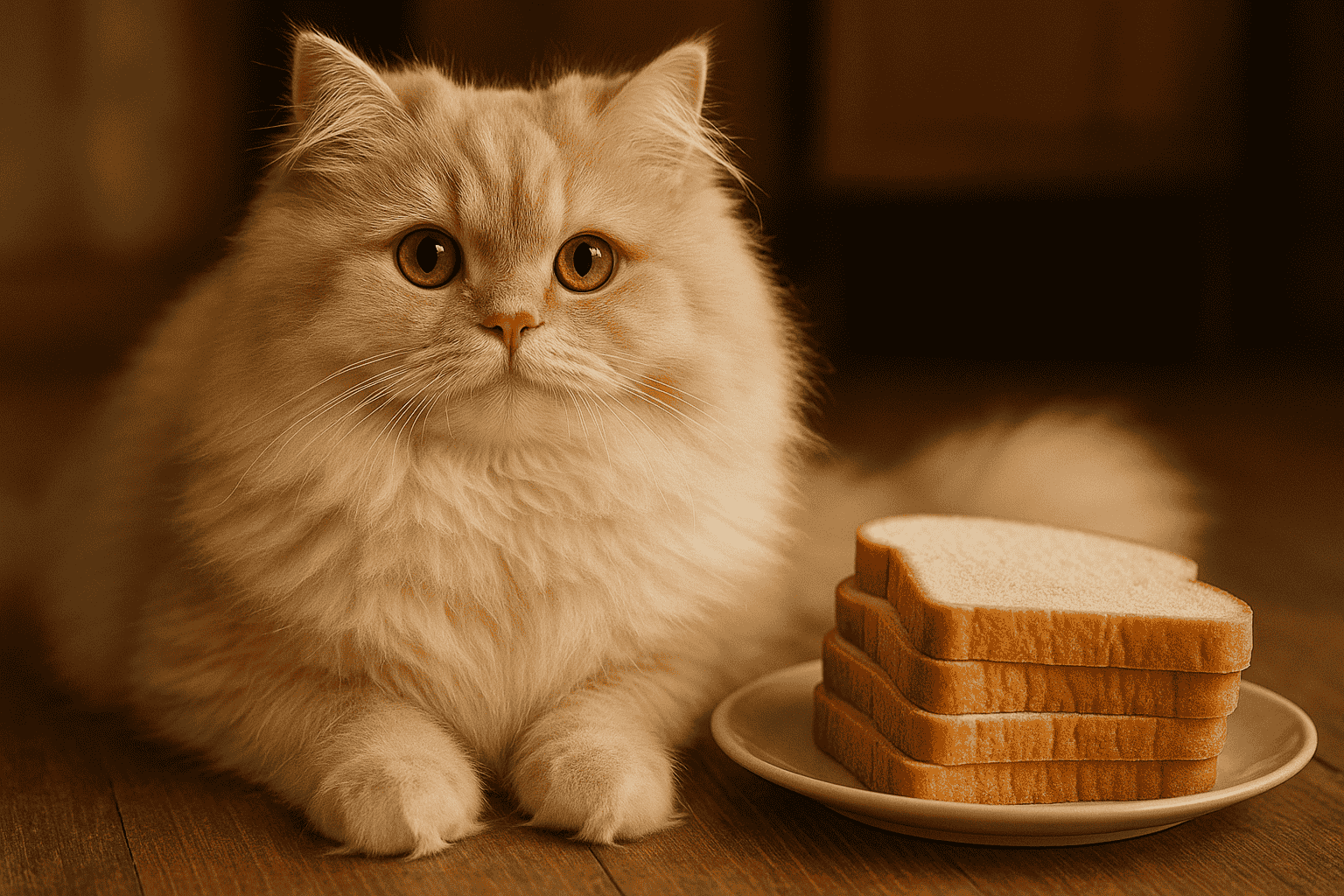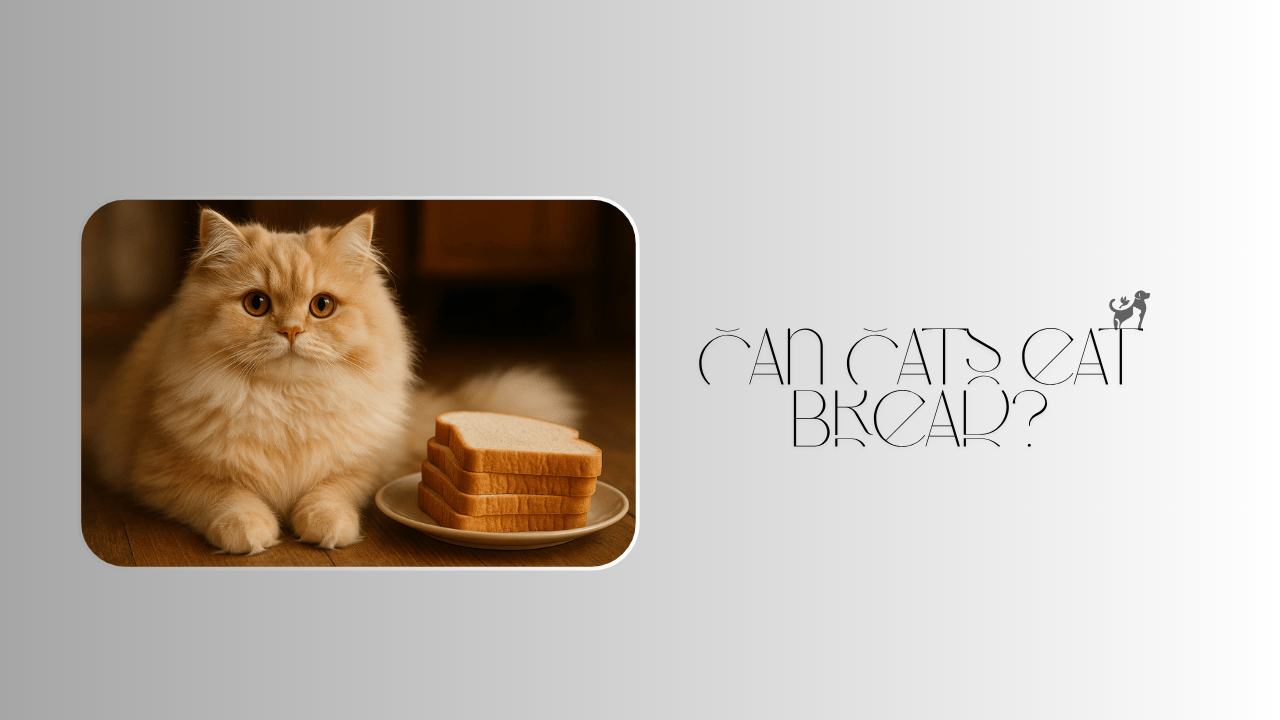Can cats eat bread? _ Cats and bread—sounds harmless, right? Many cat owners are curious whether the crust of toast or a torn-off piece of sandwich bread is okay to share with their feline companions. While bread might seem like a neutral, everyday human food, it’s important to understand how it interacts with a cat’s unique digestive system and dietary needs.
Table of Contents
ToggleThis informational guide breaks down everything you need to know: is bread safe, when is it not, and what you should watch for. Let’s explore the facts and real-world advice from pet experts.

Can Cats Eat Bread Safely?
Yes, plain bread in small amounts is generally not toxic to cats. Many cats show interest in soft foods like bread due to its smell or texture. However, while it’s not poisonous, that doesn’t mean it’s ideal—or even remotely beneficial—for their diet.
Why Cats Like Bread
Cats might sniff out your bread slice because it’s soft, warm, and smells yeasty. But this doesn’t mean their bodies can process it well. Cats are obligate carnivores, which means their systems are built to digest meat, not carbs.
Is Bread Nutritious for Cats?
Bread offers zero essential nutrients for cats. It’s primarily made of carbohydrates, which cats don’t need in large amounts. While a nibble won’t cause damage, regularly feeding your cat bread can:
- Add unnecessary calories
- Lead to obesity
- Upset sensitive stomachs
- Displace nutrient-rich foods
According to PetMD, the ideal cat diet should be high in protein, moderate in fat, and low in carbohydrates.
Types of Bread Cats Should Avoid
Not all bread is created equal, and some are dangerous for cats. Here’s a breakdown of breads you should never feed your feline:
1. Garlic or Onion Bread
Both garlic and onions are toxic to cats and can cause serious health issues like anemia.
2. Raisin Bread
Raisins are highly poisonous to cats and dogs. Even a few can lead to kidney failure.
3. Bread with Seeds or Nuts
Flaxseed, sunflower seeds, or added nuts can lead to choking or digestive problems.
4. Raw Dough
Unbaked yeast dough is extremely dangerous. It can expand in the stomach and produce alcohol, which can lead to intoxication or even death. The ASPCA warns never to let pets near rising dough.
How Much Bread Is Too Much?
Even for healthy adult cats, bread should only be a rare treat, not a regular part of their diet.
- Safe serving: A tiny piece, the size of a fingernail
- Frequency: Once a week or less
Anything more can cause digestive discomfort or encourage your cat to beg for inappropriate human foods.
Signs Bread Is Harming Your Cat
Watch for these warning signs if your cat got into the breadbasket:
- Vomiting or diarrhea
- Lethargy
- Loss of appetite
- Bloated stomach (especially if raw dough was eaten)
- Allergic reactions (itchy skin, sneezing)
If any symptoms persist, contact your veterinarian immediately.
Healthier Treat Alternatives to Bread
Want to give your cat a snack without guilt? Try these vet-recommended alternatives:
- Cooked chicken or turkey
- Freeze-dried fish
- Soft cat-specific treats with added vitamins
- Cooked pumpkin (fiber-rich and stomach-friendly)
You can also explore homemade pet recipes. Fluffze.com shares easy, safe treat ideas tailored for cats.
Expert Insight: What Vets Say
Dr. Laura Robinson, a vet contributor at PetMD, says, “Bread isn’t harmful in small bits, but we strongly discourage feeding it regularly. It fills your cat with empty calories that should be replaced with animal protein.”
Additionally, some cats may have gluten sensitivity, just like humans. If your cat scratches excessively or shows signs of skin irritation after eating bread, it’s worth evaluating their diet.
Real Owner Experiences
“My cat Luna always begged for toast crusts. I used to give her tiny pieces until one day she had an upset tummy. Since then, we switched to freeze-dried salmon, and she’s so much happier.”
– Amanda, Seattle
“We thought bread was a harmless treat until we found our cat sniffing around the raisin loaf. Glad we caught it in time!”
– Brian, Austin
These examples show that while it might feel innocent, bread can pose hidden risks when not managed carefully.
FAQ: Can Cats Eat Bread?
1. Can kittens eat bread?
It’s not recommended. Their stomachs are more sensitive, and they need nutrient-dense food while growing.
2. Is whole wheat bread safer than white bread?
Whole wheat bread contains more fiber but still lacks essential nutrients for cats.
3. What should I do if my cat eats garlic bread?
Call your vet immediately. Garlic is toxic even in small amounts.
4. Can bread cause allergies in cats?
Yes, some cats may have gluten or wheat sensitivities.
5. Are bread crusts okay?
Plain crusts in tiny pieces are safer than buttery or seasoned slices, but still should be given sparingly.
Final Thoughts & Recommendations
Can cats eat bread? Technically yes—but should they? Probably not. Bread lacks nutritional value and carries potential risks, especially when it includes added ingredients like garlic or raisins. If you want to treat your cat, stick to meat-based options or pet-formulated treats.
Visit Fluffze.com for safe, cat-tested treat guides and expert health tips.
Written by Shawn, pet lover & contributor at Fluffze
Related Articles:
Can Cats Eat Blueberries? A Safe & Tasty Guide for Cat Parents
Dangerous Foods Cats Should Not Eat
Can Cats Eat Raw Fish? Expert Advice
Can Cats Eat Ice Cream?





